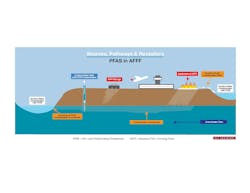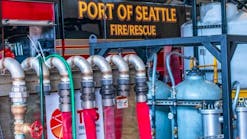Per- and Polyfluoroalkyl substances (PFAS) consist of thousands of man-made chemicals that have many manufacturing and industrial applications. PFAS have been used over the last 65 years to make everyday products more resistant to stains, grease and water.
PFAS are used to keep food from sticking to cookware, to make sofas and carpets resistant to stains, or to make clothes and mattresses more waterproof. It’s found in cleaners, textiles, leather, paper, paints and wire insulation.
PFAS are also key components in aqueous film-forming foam (AFFF), which is used to fight petroleum-based fires at aviation and manufacturing facilities. For decades, AFFF containing PFAS has been used extensively at airports throughout the world to protect the safety of passengers, crew and others. The U.S. Federal Aviation Administration (FAA) requires that commercial airports train with, calibrate equipment with, and use the best performing AFFF fire suppression systems. AFFF is required to be used at airports and must be certified to meet strict performance specifications, including the U.S. Department of Defense Military Specifications. The chemical properties of PFAS is what makes AFFF so effective at suppressing fires. In effect, AFFF forms a dense “foam blanket” that prevents oxygen from reaching the fire and smothers it.
Why are PFAS dangerous?
Health studies have shown PFAS present risks to human health. Exposure to PFAS exceeding certain levels may result in adverse health effects, including cancer (e.g., testicular, kidney), developmental effects to fetuses during pregnancy or to breastfed infants (e.g., low birth weight, accelerated puberty, skeletal variations), liver effects (e.g., tissue damage), immune effects (e.g., antibody production and immunity), thyroid effects, and other effects (e.g., cholesterol changes).
PFAS are environmentally persistent and do not easily break down. As such, these compounds are found globally in the environment including bodies of water, soil, dust and in the air. They bioaccumulate (accumulate in individual organisms) and biomagnify (accumulate in the food chain) and are consequently found in most human blood. PFAS do not readily degrade in the environment to constituents that are not PFAS.
From AFFF to the food chain
PFAS can travel long distances, move through soil, seep into groundwater, or be carried through air. AFFF is released to the environment under various scenarios. At airports AFFF is deployed intentionally for either training, testing and operational requirements or emergency response. It may also be accidentally released during delivery, transfer and storage. In the past, the hazards to human health and the environment were not as well-known as they are today and there were few guidelines in the handling and management of AFFF and wastewater contaminated with foam. Wastewater contaminated with AFFF (e.g. fire fighting runoff) was often treated like storm water and was allowed to seep into soil or was discharged as surface water runoff. Storage tanks and drums containing AFFF do sometimes leak and, in this case, can release PFAS to the subsurface. PFAS and PFAS contamination will migrate downward within the soil column. If the mass is great enough, it can migrate and contaminate groundwater. The contaminated groundwater can then reach sensitive receptors by being extracted by drinking water wells or by recharging surface water features, such as rivers or creeks. In both instances, the PFAS become part of the food chain by being ingested by humans and wildlife.
Regulatory climate
The U.S. Environmental Protection Agency (EPA) reviewed the “best available peer-reviewed studies” including research on laboratory animals (rats and mice) and findings reported by epidemiological studies of human populations that have been exposed to PFAS. Subsequently, the EPA issued a health advisory for these contaminants in May of 2016. The EPA lifetime Health Advisory Level (HAL) for two of the most well-know PFAS, perfluorooctanoic acid (PFOA) and perfluorooctanesulfonic acid (PFOS) have been established as 0.070 micrograms per liter (μg/L) or 70 parts per trillion (PPT) in drinking water. The concentration of 70PPT is the equivalent to about three-and-a-half drops of water in an Olympic-sized swimming pool. The fact PFAS are even measured in parts-per-trillion is an indicator of its risk potential. The EPA has not yet established any enforceable regulatory criteria or released health advisories for the wider family of PFAS compounds, nor has it designated any PFAS compounds as “hazardous substances” (under Superfund) or as “hazardous wastes” (under the Resource Conversation Recovery Act (RCRA).
Critics, scientists, and others charged with protecting public health, feel that the HAL of 70PPT is not stringent enough and the federal government is not moving fast enough to address this pervasive contamination issue. In fact, many states are enacting their own rules, regulations and enforceable standards to assure public safety. Many states are actively involved with addressing PFAS contamination across multiple regulatory programs and the regulatory requirements throughout the U.S. and the regulatory environment is rapidly changing. The Interstate Technology Regulatory Council (ITRC) is tracking and updating state/country requirements on a monthly basis and has become the “go-to” information bank for environmental professionals to keep abreast of new requirements in this ever changing regulatory landscape.
Contamination investigations at airport
The increase in regulatory attention to PFAS has led to rapidly evolving environmental requirements for airports. So, it stands to reason that airports across the country are being tested for PFAS contamination as it’s considered to be a likely contributor to PFAS contamination in the vicinity of the airport. Although the presence and extent of potential environmental impact depends on the nature and history of past AFFF use at each airport, the use of AFFF has been mandated at airports across the nation and consequentially PFAS contamination is being found during environmental investigations at many of these airports.
The California State Water Boards have decided to take a “phased approach” in requiring different industries to investigate their properties for PFAS contamination. Not surprisingly, Californian Airports are at the top of the Phase I List. In March 2019, the State Water Boards requested that 27 airports in California submit workplans to test their facilities for PFAS. Investigation typically involves drilling borings to collect soil samples and installation of temporary or permanent groundwater monitoring wells to collect groundwater samples. The investigation will likely not only need to be conducted where the AFFF was used for storage and training but also where it was used during an emergency response. Often this is near active runways and in other high risk areas. All environmental assessment work is difficult and expensive and is a complicated logistical dance between different divisions, who operate somewhat independently at airports. Add in the need to investigate these difficult access areas with additional permitting/ coordination, and the logistical dance becomes a nightmare. A total of 524 airports across the US were required by the FAA to use AFFF and all can be considered suspect for PFAS contamination. However, as of yet no other regions in the US have state-wide mandated airport investigations, but the environmental industry anticipates that it is coming soon.
The list is still growing, but so far 152 airport/heliport sites in Canada and 20 airports in Australia have confirmed releases of PFAS at airport facilities. The Department of Defense is investigating past PFAS contamination and has identified over 400 military sites with significant legacy PFAS concerns, many of them either at air bases or airports. Airports are not required by law to investigate PFAS contamination. Still, there are more than 75 lawsuits across the country against entities that have discharged the foam containing PFAS, and the number is growing. In Europe, Stockholm Arlanda Airport and Copenhagen Airport may be important sources for long-term contamination of the nearby environment with PFAS.
PFAS-related operations/environmental management and litigation
As a result of the growing concern over PFAS, airports face operational and environmental challenges relative to the existing and previous storage, use, testing and/or disposal of AFFF. The primary impacts to operations are related to firefighting activities — specifically, how airports procure, store, handle, apply, remove and dispose of AFFF. With regard to environmental management, PFAS will have a potentially significant impact on how environmental media are investigated and remediated and has the potential to significantly affect capital improvement projects should contamination of PFAS be encountered.
All airports should carefully examine their current and past use of these foams and take steps to manage the liability risks associated with them. Some airport industry officials hope that, because the FAA requires airports to use firefighting foam that contains PFAS, the airports won’t be held liable for letting it contaminate their properties. Not every lawyer thinks this argument will hold up and a lobbying group for the airport industry is pushing Congress to pass a law that will limit their financial exposure. As the legal questions get sorted out, airports across the country are deciding whether and how to respond to the potential health consequences for residents who live nearby.
To gauge the level of awareness and gain a better understanding of management practices, the Transportation Research Board (TRB), a division of the National Academies of Science Engineering Medicine, conducted an extensive survey of 167 North American airports. As a result, the TRB published a document regarding the Use and Potential Impacts of AFFF containing PFAS at Airports. Within this document is a link to a screening tool (i.e., a macros-enabled Microsoft Excel™ workbook) to better integrate best management practices into the AFFF life cycle at airport facilities, identify and manage potential risks associated with historical and/or current AFFF use at their site, and prioritize where resources need to be allocated to address concerns regarding AFFF and PFAS. The tool can be accessed at the TRB website.
The very basic best practices are:
- Avoid direct release to the environment to the greatest extent possible.
- Collect, treat and properly dispose of runoff/wastewater from training events or live fire events to the greatest extent possible.
- Make note of sensitive receptors (for example, streams, lakes, homes, areas served by wells) identified in the vicinity of foam use and report to environmental agencies as required.
Alternatives to Traditional AFFF
Congress is urging the FAA to allow airports to use PFAS-free foams. However, the FAA has been slow to respond and a timeline for action is unclear. Alternatives are described in two categories, fluorinated foams and fluorine-free foams. While some fluorine-free foams are being used in Europe, England and Australia, there are currently no fluorine-free foams that meet specifications for use in emergency response at North American airports. All of the 27 major Australian airports have transitioned to fluorine-free firefighting foams, as have the following major hub airports: Dubai, Dortmund, Stuttgart, London Heathrow, Gatwick, Edinburgh, Manchester, London City, Leeds-Bradford, Copenhagen and Auckland, and elsewhere in Europe such as Billund, Guernsey, Bristol, Blackpool, and Koln-Bonn.
United States and pursuant to the Canadian Environmental Protection Act, North American manufacturers have changed their AFFF formulations so that they are free of PFOS and PFOA which at this point are believed to be two of the most prevalent and potentially problematic PFAS. Current AFFF formulations in North America now contain other PFAS, which are thought to present less human health or environmental risk, but there are limited studies that have evaluated the behavior of these PFAS and the potential risks they pose to human health or the environment. However, it is known that the “replacement PFAS” in AFFF (often referred to as “short-chain PFAS”) are more likely to be found in aqueous phases (i.e., water), whereas “long-chain” PFAS like PFOS and PFOA, don’t migrate as far in the soil.
While current AFFF formulations do not contain PFOA or PFOS, many of those older formulations still exist because they have long shelf-lives and were purchased before those compounds were phased out. Past firefighting, training, equipment maintenance and storage practices at Airports have left behind years of built up legacy contamination, the extent of which is only being determined now. Although advances have been made in risk management strategies and remediation technologies, research to identify applicable, cost-effective approaches to managing the impacts of AFFF and related PFAS at airports is ongoing.
Lynleigh Love is a Professional Geologist and Senior Project Manager at SCS Engineers in Long Beach, California. She has 23 years of experience with environmental site assessment and remediation of contaminated soils and groundwater in Southern California. She manages due diligence projects for property redevelopment and addresses legacy contamination. She is experienced in expert witness litigation and has worked with several state environmental protection agencies with the preparation of statewide litigation projects against large corporations.
Chris Crosby is a Project Manager at SCS Engineers in San Diego, California. He has over 13 years of professional experience in the environmental consulting field. He successfully manages complex environmental site assessments, subsurface investigations, and remediation projects to help navigate regulatory requirements and meet client objectives. He routinely investigates a variety of constituents of concern at properties with soil, groundwater, and vapor intrusion impacts due to releases from historical site uses and implements appropriate remediation technologies to restore properties to be protective of human health and the environment.





